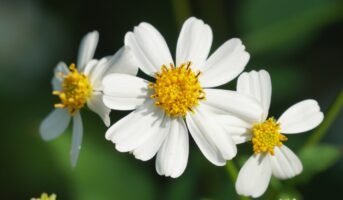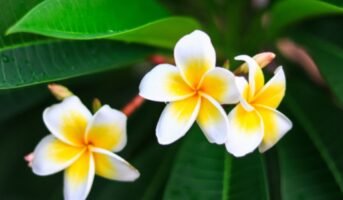Sphagneticola trilobata is a flowering plant that belongs to the Asteraceae family. The plant goes by its most common names, such as Bay Biscayne creeping-daisy, Singapore oxey, and wedelia. The plant is a creeper with a soft stem that trails along other trees or grows in open fields. This outdoor plant thrives on sunlight and grows very rapidly.
The plant bears small, fleshy green leaves. The leaves are shaped like small arrowheads and are usually very soft to touch. The speciality of the plant is its flowers which appear to be bright yellow. These small and round yellow flowers have 9-10 petals and look like daisies. Hence, they are known as creeping daisies and sometimes yellow daisies.

Source: Pinterest
Sphagneticola trilobata is actually pretty commonly found since it grows well in the wild. The plant is native to South and Central America and is commonly found in meadows and pastures. The plant also grows and spreads rapidly, so it’s known to be pretty invasive.
Facts about Sphagneticola trilobata
| Name: | Sphagneticola trilobata |
| Common Name: | Wedelia, Creeping Daisy, Yellow Daisy |
| Type: | Creeper |
| Season: | All year |
| Temperature: | 25-35°C |
| Soil: | Any type, well-drained |
| Water: | Regularly |
| Light: | Plenty of sunlight |
| Indoor/Outdoor: | Outdoor |
| Placement: | Balcony, Patio, Fence, Roof, Window Sill |
How to grow and maintain Sphagneticola trilobata
Sphagneticola trilobata is actually pretty easy to maintain and grow. They spread rapidly in the wild and tend to thrive even in the harshest weather. Surprisingly, the plant can survive extreme temperatures.
The Sphagneticola trilobata plant is best for beginners and people who cannot dedicate too much time to plants. If you forget to water your plants for a while, do not worry; they will still survive.

Source: Pinterest
Here are some of the pro-tips that will help you grow Wedelia better:-
-
Soil
Sphagneticola trilobata can survive in literally any range of pH level and soil. Since they are so low maintenance, they don’t need much attention at all. The best soil for the plant would be any type of garden soil mixed with a little organic fertiliser. They can survive drought, so hard soil won’t be a problem either. However, for best growth, it is recommended to use an organic fertiliser mix once every six months.
-
Sunlight
Wedelia or Sphagneticola trilobata is entirely an outdoor plant and thrives in sunlight. It can survive even in full shade, but it tends to grow slower without sunlight. In full sun, the plant produces the most bloom and grows pretty rapidly. When planting Sphagneticola trilobata, make sure they receive plenty of light for at least 4-5 hours a day.
-
Water
The plant grows pretty rapidly and is actually one of the most invasive species of plants on Earth. Therefore, you should try to water them minimally to avoid overgrowth. Watering them like succulents will be good enough. Also, avoid over-watering them to compensate for the time gap.
Benefits of Sphagneticola trilobata
Sphagneticola trilobata may look like a wild and unwanted plant, but it contains some hidden benefits that are not visible to the naked eye. Let’s examine some of the advantages:
Ornamental
Sphagneticola trilobata is cultivated and gardened for its ornamental beauty that adds a pop of colour even in the dullest corner. The plants are grown in the yard and in empty garden spaces to make them look more appealing than concrete. In fact, many people are now shifting to using these flowers to fill out their gardens instead of planting plain or fake grass.
Medicinal
The extracts of the plant are exceptionally useful in curing many illnesses and diseases.
Many studies have even found them to be a great cure for certain cancers. When the extracts of the plant are combined with other ingredients and turned into medicines, they can be consumed to treat various health problems. Although they are not edible directly, they can be processed by pharmaceutical companies to make life-saving medicines.
Here are some of the top health benefits of Sphagneticola trilobata that make it super useful:-
- The plant contains ethanolic extracts that are proven to be great for treating wounds. It is used in a variety of ointments and creams and applied on open wounds and bruises to heal them faster.
- The oil extracted from Sphagneticola trilobata can be useful in treating and preventing the growth of cancer. It has antioxidant properties that help limit the growth of certain cancers.
- The anti-inflammatory nature of Sphagneticola trilobata makes it an excellent cure for bloating and swelling from infections.
- The anti-hepatotoxic nature of the plant can be useful in the treatment and prevention of liver damage or diseases.
FAQs
Where does Sphagneticola trilobata grow?
The Sphagneticola trilobata widely grows in the pastures and fields of Central and South America. It is pretty commonly found in Mexico.
Are Sphagneticola trilobata plants invasive?
Yes, Sphagneticola trilobata plants are extremely invasive. It is recommended to check with your local authorities before planting them at home.
When does Sphagneticola trilobata flower?
Sphagneticola trilobata flowers grow throughout the year, especially in tropical climates.
Housing News Desk is the news desk of leading online real estate portal, Housing.com. Housing News Desk focuses on a variety of topics such as real estate laws, taxes, current news, property trends, home loans, rentals, décor, green homes, home improvement, etc. The main objective of the news desk, is to cover the real estate sector from the perspective of providing information that is useful to the end-user.
Facebook: https://www.facebook.com/housing.com/
Twitter: https://twitter.com/Housing
Email: [email protected]










